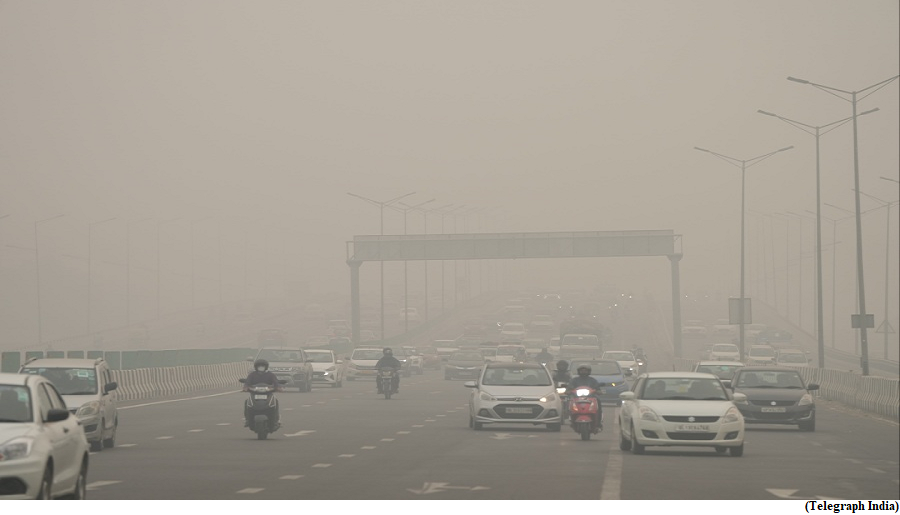Delhi NCR air emergency, Challenges and the way forward (GS Paper 3, Environment)

Context:
- Delhi, the capital city, finds its air quality increasingly in the ‘severe’ or ‘severe plus’ category. Looking back at the millions spent and considering the future health of its citizens, introspection on where it may have gone wrong becomes the most critical question to ponder.
- Continuing with the same approach and expecting different results would be akin to insanity.
Issue of smog:
- There is need to realise that smog is not only a Delhi problem. Delhi’s unique circumstances may highlight the problems, but the smog blankets an area spanning over 700,000 sq km, encompassing the entire Indo-Gangetic plains across several states, climates, and cultures.
- The magnitude of the problem becomes comprehensible only when people realise the sub-continental size of the phenomenon in action, shaped by the North-West winds and the mighty Himalayas defining the eastern frontiers of the smog.
- At this scale, the most vivid depictions of the problem can be seen from space, where the entire Indo-Gangetic plain is covered in smoke.
- The first step in addressing the problem is to recognise that India’s most densely populated regions share the burden of breathing the same polluted air.
Dimension of time:
- Treating smog as an exceptional problem has conditioned to address it in a similar manner. Delhiites have become accustomed to the annual filing of public interest litigations, the introduction of fancy new ideas and technologies, all of which, at their core, aim to cleanse the pollutants from the skies, along with the recurring promises of political action. If the weather permitted, there would certainly be protests as well.
- However, behind the smog lies several year-round factors, including the challenges of managing increased bio-mass disposal resulting from a new harvesting cycle, bio-fuel combustion, the growing number of vehicles on the roads, and ongoing industrial pollution.
- These pollutants persist in our air throughout the year. While the smog’s presence is more pronounced in the winter months, we must bear in mind that it is a continuous concern throughout the year. Change must, therefore, not be situational or locked in time.
- The entire Indo-Gangetic plain must unite and remain steadfast in their collective endeavor to combat this issue.
Scientific approach:
- One must be ready to retrospect and critically evaluate the measures we have implemented over the past several years. In the past decade, various agencies initiated different steps to control air pollution.
Water sprinkling or anti-smog guns:
- For example, the utilisation of water or dust-suppressant-based technologies. Acknowledging the impact in the initial years is important, but it’s evident that the effect is minimal given this scale of the smog.
- Employing technology without a scientific foundation may assist those implementing these measures in fulfilling checkboxes, but it does little to address the problem.
- At the very least, the use of the water sprinkling or anti-smog guns needs optimisation, ensuring that nozzle size and droplet adjustments align with the technological requirements.
- One must also understand that the unrestrained use of such technologies may give rise to additional problems. For instance, scientific studies show that water spraying may actually become the catalyst for the formation of secondary particulates.
Mechanical sweeping:
- Similarly, mechanical sweeping of our roads, particularly when they are riddled with potholes, is no better than undertaking busywork. Even though bags of dust may be collected, the persistent potholes ensure that more dust is continuously generated.
Smog towers:
- The much-hyped smog towers represent a case where scientific understanding has been lacking. Their necessity and efficacy seem confined to specific areas such as Delhi.
- Smog towers function by employing filtration as their core principle, where dust is trapped and later removed. Even if the system manages to accumulate a few tonnes of dust in a year, it has an insignificant impact on the overall ambient air quality.
- Therefore, adopting such techniques should be based on comprehensive scientific analysis rather than solely relying on assumptions. Filtration is not an answer in a dynamic system and may have limited impacts in a closed system.
Community approach:
- There’s a crucial need for personal engagement. While steps such as proper construction waste disposal, curtailing biomass burning, and using vehicles judiciously must be taken, a culture of change should be nurtured.
- It’s important to recall that the initial push against air pollution in Delhi stemmed from public outcry from images of soot-covered collars and coughing masses.
Way Forward:
- Only when policymakers prioritise the air we breathe as a critical issue will we witness the impetus for a cleaner Delhi. Without this, the problem will merely be deferred.
- We must stand together to safeguard institutions, whether governmental, academic, or civil society, that are dedicated to researching and providing solutions to the problem.


